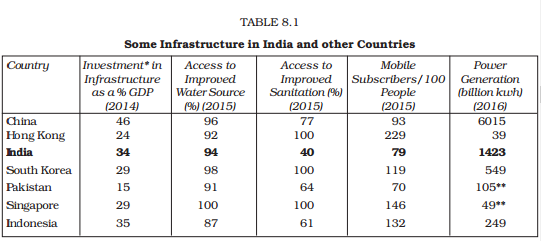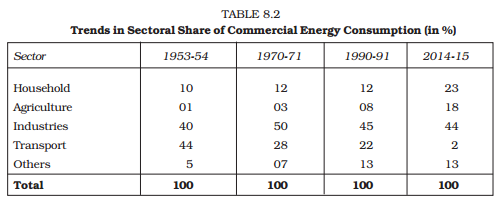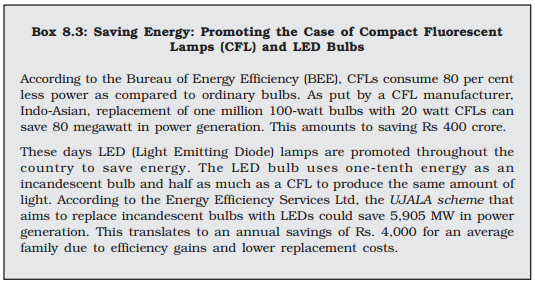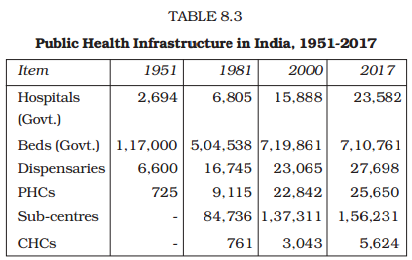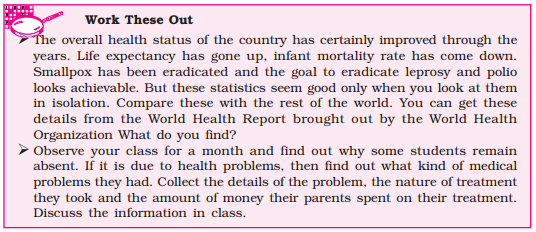Table of Contents
8
INFRASTRUCTURE
After studying this chapter, the learners will
• understand the main challenges India faces in the areas of social and economic infrastructure
• know the role of infrastructure in economic development
• understand the role of energy as a critical component of infrastructure
• understand the problems and prospects of the energy and health sectors
• understand the health infrastructure of India.
“Many things we need can wait, the child cannot. To him, we cannot say, ‘tomorrow’. His name is today.”
Gabrriella Mistral—Chilean poet
So is the Infrastructure.
After studying this chapter, the learners will
• understand the main challenges India faces in the areas of social and economic infrastructure
• know the role of infrastructure in economic development
• understand the role of energy as a critical component of infrastructure
• understand the problems and prospects of the energy and health sectors
• understand the health infrastructure of India.
“Many things we need can wait, the child cannot. To him, we cannot say, ‘tomorrow’. His name is today.”
Gabrriella Mistral—Chilean poet
So is the Infrastructure.
8.1 Introduction
Have you ever thought of why some states in India are performing much better than others in certain areas? Why do Punjab, Haryana and Himachal Pradesh prosper in agriculture and horticulture? Why are Maharashtra and Gujarat industrially more advanced than others? How come Kerala, popularly known as ‘God’s own country’, has excelled in literacy, health care and sanitation and also attracts tourists in such large numbers? Why does Karnataka’s information technology industry attracts world attention?

It is all because these states have better infrastructure in the areas they excel than other states of India. Some have better irrigation facilities. Others have better transportation facilities, or are located near ports which makes raw materials required for various manufacturing industries easily accessible. Cities like Bengaluru in Karnataka attract many multinational companies because they provide world-class communication facilities. All these support structures, which facilitate development of a country, constitute its infrastructure. How then does infrastructure facilitate development?
8.2 What is Infrastructure?
Infrastructure provides supporting services in the main areas of industrial and agricultural production, domestic and foreign trade and commerce. These services include roads, railways, ports, airports, dams, power stations, oil and gas pipelines, telecommunication facilities, the country’s educational system including schools and colleges, health system including hospitals, sanitary system including clean drinking water facili-ties and the monetary system including banks, insurance and other financial institu-tions. Some of these facilities have a direct impact on production of goods and services while others give indirect support by building the social sector of the economy.
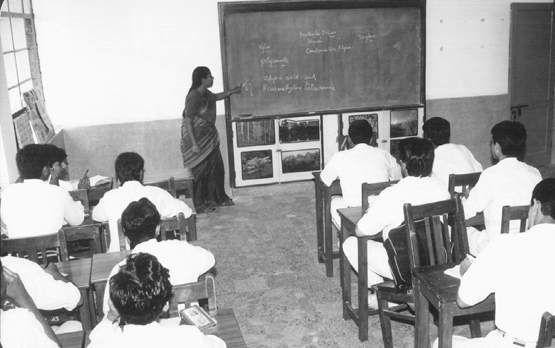
Fig. 8.2 Schools: an important infrastructure for a nation
Some divide infrastructure into two categories — economic and social. Infrastructure associated with energy, transportation and communication are included in the former category whereas those related to education, health and housing are included in the latter.
Work This Out
Ø In your locality or neighbourhood you might be using a variety of infrastructure. List all of those. Your locality may also be requiring a few more. List those separately.
8.3 Relevance of Infrastructure
Infrastructure is the support system on which depends the efficient working of a modern industrial economy. Modern agriculture also largely depends on it for speedy and large-scale transport of seeds, pesticides, fertilisers and the produce using modern roadways, railways and shipping facilities. In recent times, agriculture also depends on insurance and banking facilities because of its need to operate on a very large scale.
Infrastructure contributes to economic development of a country both by increasing the productivity of the factors of production and improving the quality of life of its people. Inadequate infrastructure can have multiple adverse effects on health. Improvements in water supply and sanitation have a large impact by reducing morbidity (meaning proneness to fall ill) from major waterborne diseases and reducing the severity of disease when it occurs. In addition to the obvious linkage between water and sanitation and health, the quality of transport and communication infrastructure can affect access to health care. Air pollution and safety hazards connected to transportation also affect morbidity, particularly in densely populated areas.
8.4 The State of Infrastructure in India
Traditionally, the government has been solely responsible for developing the country’s infrastructure. But it was found that the government’s investment in infrastructure was inadequate. Today, the private sector by itself and also in joint partnership with the public sector, has started playing a very important role in infrastructure development.
A majority of our people live in rural areas. Despite so much technical progress in the world, rural women are still using bio-fuels such as crop residues, dung and fuel wood to meet their energy requirement. They walk long dis-tances to fetch fuel, water and other basic needs. The census 2001 shows that in rural India only 56 per cent households have an electricity connection and 43 per cent still use kerosene. About
90 per cent of the rural households use bio-fuels for cooking. Tap water availability is limited to only 24 per cent rural households. About 76 per cent of the population drinks water from open sources such as wells, tanks, ponds, lakes, rivers, canals, etc. Access to improved sanitation in rural areas was only 20 per cent.
Look at Table 8.1 which shows the state of some infrastructure in India in comparison to a few other countries. Though it is widely understood that infrastructure is the foundation of development, India is yet to wake up to the call. India invests only 34 per cent of its GDP on infrastructure, which is far below that of China and Indonesia.
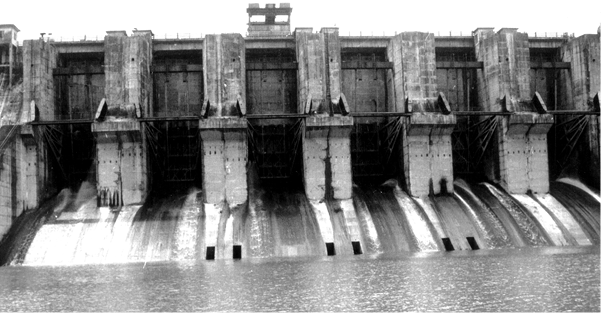
Fig. 8.3 Dams: temples of development
Some economists have projected that India will become the third biggest economy in the world a few decades from now. For that to happen, India will have to boost its infrastructure investment. In any country, as the income rises, the composition of infrastructure requirements changes significantly. For low-income countries, basic infrastructure services, like irrigation, transport and power, are more important. As economies mature and most of their basic consumption demands are met, the share of agriculture in the economy shrinks and more service-related infrastructure is required. This is why, the share of power and telecommunication infrastructure is greater in high-income countries.

Fig. 8.4 Safe drinking water with pucca house: still a dream
Thus, development of infrastructure and economic development go hand in hand. Agriculture depends, to a considerable extent, on the adequate expansion and development of irrigation facilities. Industrial progress depends on the development of power and electricity generation, transport and communications. Obviously, if proper attention is not paid to the development of infrastructure, it is likely to act as a severe constraint on economic development. In this chapter the focus will be on only two kinds of infrastructure—those associated with energy and health.
Source: World Development Indicators 2017, World Bank website: www.worldbank.org./ (*) refers to Gross Capital Formation; https://yearbook.enerdata.net (**data pertaining to 2014)
Work These Out
Ø While reading newspapers you will come across terms like Bharat nirman, Special Purpose Vehicle (SPV), Special Economic Zones (SEZ), Build Operate Transfer (BOT), Private Public Partnership (PPP) etc. Make a scrapbook of news items containing these terms. How are these terms related to infrastructure?
Ø Using the references at the end of the chapter, collect the details of other infrastructure.
8.5 Energy
Why do we need energy? In what forms is it available? Energy is a critical aspect of the development process of a nation. It is, of course, essential for industries. Now it is used on a large scale in agriculture and related areas like production and transportation of fertilisers, pesticides and farm equipment. It is required in houses for cooking, household lighting and heating. Can you think of producing a commodity or service without using energy?
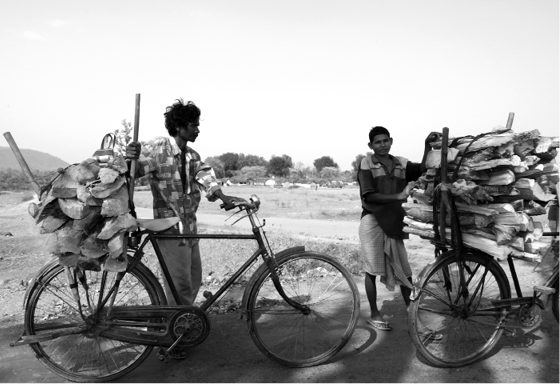
Fig. 8.5 Fuel wood is the major source of energy
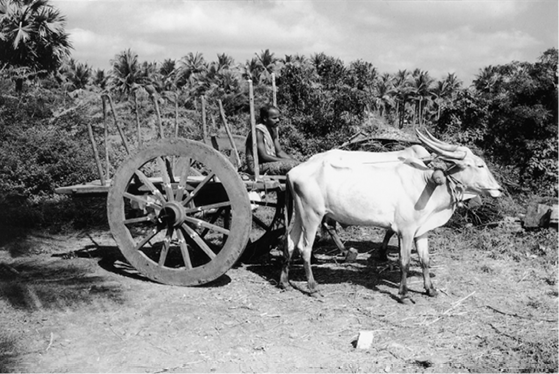
Fig. 8.6 Bullock carts still play a crucial role in rural transportation market
Sources of Energy: There are commercial and non-commercial sources of energy. Commercial sources are coal, petroleum and electricity as they are bought and sold. Non-commercial sources of energy are firewood, agricultural waste and dried dung. These are non-commercial as they are found in nature/forests.
While commercial sources of energy are generally exhaustible (with the exception of hydropower), non-commercial sources are generally renewable. More than 60 per cent of Indian households depend on traditional sources of energy for meeting their regular cooking and heating needs.
Non-conventionalSources of Energy: Both commercial and non-commercial sources of energy are known as conventional sources of energy. There are three other sources of energy which are commonly termed as non-conventional sources — solar energy, wind energy and tidal power. Being a tropical country, India has almost unlimited potential for producing all three types of energy if some appropriate cost effective technologies that are already available are used. Even cheaper technologies can be developed.
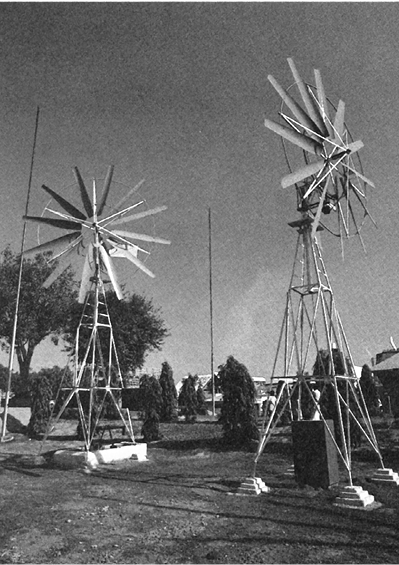
Consumption Pattern of Commercial Energy: In India, commercial energy consumption makes up about 74 per cent of the total energy consumed in India. This includes coal with the largest share of 54 per cent, followed by oil at 32 per cent, natural gas at 10 per cent and hydro energy at 2 per cent. Non-commercial energy sources consisting of firewood, cow dung and agricultural wastes account for over 26 per cent of the total energy consumption. The critical feature of India’s energy sector, and its linkages to the economy, is the import dependence on crude and petroleum products, which is likely to grow rapidly in the near future.
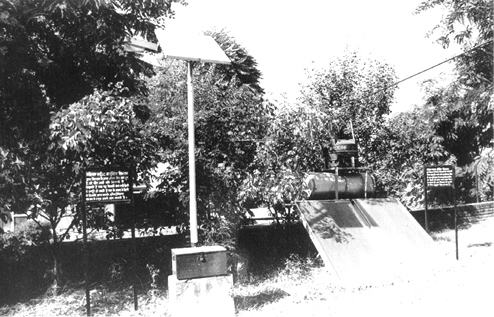
The sectoral pattern of consumption of commercial energy is given in Table 8.2. The transport sector was the largest consumer of commercial energy in 1953-54. However, there has been continuous fall in the share of the transport sector while the shares of the household, agriculture and industrial sector have been increasing. The share of oil and gas is the highest among all commercial energy consumption. With the rapid rate of economic growth, there has been a corresponding increase in the use of energy.
Power/Electricity: The most visible form of energy, which is often identified with progress in modern civilisation, is power, commonly called electricity. It is a critical component of infrastructure that determines the economic development of a country. The growth rate of demand for power is generally higher than the GDP growth rate. Studies point out that in order to have 8 per cent GDP growth per annum, power supply needs to grow around 12 per cent annually.

In India, in 2016, thermal sources accounted for 67 per cent of the power generation capacity. Hydel power accounted for 14 per cent, while nuclear power accounted for only 2 per cent. India’s energy policy encourages two energy sources — hydel and wind — as they do not rely on fossil fuel and, hence, avoid carbon emissions. Yet, this has not resulted in faster growth of electricity produced from these two sources.
Work These Out
Ø Among other sources of energy, you would have noticed that a marginal share of energy comes from nuclear power. Why?
Ø Solar energy, wind power and power produced from tides are going to be the future sources of energy. What are their comparative merits and demerits? Discuss in the class.
Atomic energy is an important source of electric power, it has economic advantages. At present, nuclear energy accounts for only 2 per cent of the total energy consumption, against a global average of 13 per cent. This is far too low. Hence, some scholars suggest to generate more electricity through atmoic (nuclear) sources and yet a few others object about this, from the viewpoint of environment and sustainable development. What do you think?
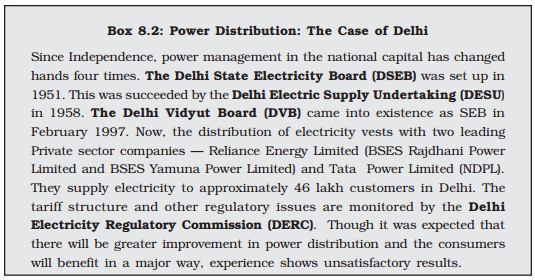
Some Challenges in the Power Sector: Electricity generated by various power stations is not consumed entirely by ultimate consumers; a part is consumed by power station auxiliaries. Also, while transmitting power, a portion is lost in transmission. What we get in our houses, offices and factories is the net availability.
Some of the challenges that India’s power sector faces today are — (i) India’s installed capacity to generate electricity is not sufficient to feed an annual economic growth of 7–8 per cent. In order to meet the growing demand for electricity, India’s commercial energy supply needs to grow at about 7 per cent. At present, India is able to add only 20,000 MW a year. Even the installed capacity is under-utilised because plants are not run properly
(ii) State Electricity Boards (SEBs), which distribute electricity, incur
losses which exceed Rs 500 billion. This is due to transmission and distribution losses, wrong pricing of electricity and other inefficiencies. Some scholars also say that distribution of electricity to farmers is the main reason for the losses; electricity is also stolen in different areas which also adds to the woes of SEBs (iii) private sector power generators are yet to play their role in a major way; same is the case with foreign investors (iv) there is general public unrest due to high power tariffs and prolonged power cuts in different parts of the country, and (v) thermal power plants, which are the mainstay of India’s power sector are facing shortage of raw material and coal supplies.
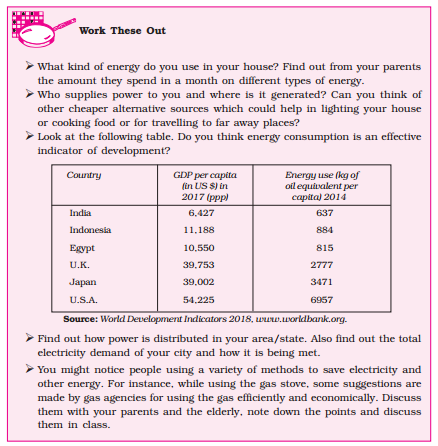
thus, continued economic development and population growth are driving the demand for energy faster than what India is producing currently. More public investment, better research and development efforts, exploration, technological innovation and use of renewable energy sources can ensure additional supply of electricity. Instead of investing in the power sector by adding to the installed capacity, the government has gone for privatisation of the power sector, and particularly, distribution (see Box 8.2), and allowed much higher prices for electricity that have impacted certain sectors very badly (see Box 3.3). Do you think it is a right policy?
8.6 Health
Health is not only absence of disease but also the ability to realise one’s potential. It is a yardstick of one’s well being. Health is the holistic process related to the overall growth and development of the nation. Though the twentieth century has seen a global transformation in human health unmatched in history, it may be difficult to define the health status of a nation in terms of a single set of measures. Generally, scholars assess people’s health by taking into account indicators, like infant mortality and maternal mortality rates, life expectancy and nutrition levels, along with the incidence of communicable and non- communicable diseases.
Source: Ninth Five year Plan, Vol. II, Chapter 6, Planning Commission, Government of India, New Delhi and Energy Statistics 2016, Central Statistical Office, Ministry of Statistics and Programme
Implementation, Government of India.
Development of health infra-structure ensures a country of healthy manpower for the production of goods and services. In recent times, scholars argue that people are entitled to health care facilities. It is the responsibility of the government to ensure the right to healthy living. Health infrastructure includes hospitals, doctors, nurses and other para-medical professionals, beds, equipment required in hospitals and a well-developed pharmaceutical industry. It is also true that mere presence of health infrastructure is not sufficient to have healthy people. The same should be accessible to all people. Since, the initial stages of planned development, policy-makers envisaged that no individual should fail to secure medical care, curative and preventive, because of the inability to pay for it. But are we able to achieve this vision? Before we discuss various health infrastructure, let us discuss the status of health in India.
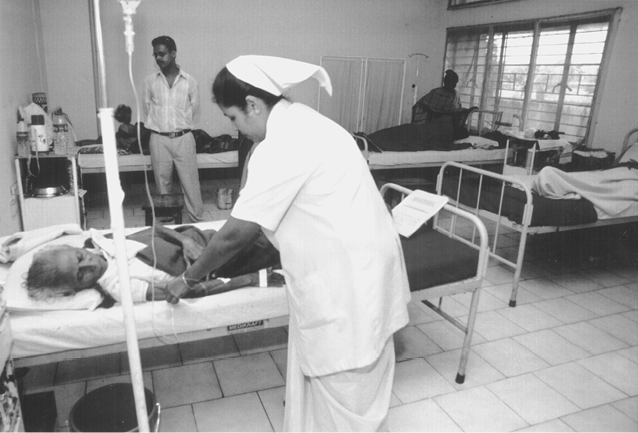
State of Health Infra-structure: The government has the constitutional obligation to guide and regulate all health-related issues, such as medical education, adulteration of food, drugs and poisons, medical profession, vital statistics, mental deficiency and lunacy. The Union Government evolves broad policies and plans
through the Central Council of Health and Family Welfare. It collects information and renders financial and technical assistance to State governments, Union Territories and other bodies for the implementation of important health programmes in the country.
Over the years, India has
built a vast health infrastructure and manpower at different levels. At the village level, a variety of hospitals, technically known as Primary Health Centres (PHCs), (see also Box 8.5), have been set up by the government. India also has a large number of hospitals run by voluntary agencies and the private sector. These hospitals are manned by professionals and para-medical professionals trained in medical, pharmacy and nursing colleges.
Since Independence, there has been a significant expansion in the physical provision of health services. During 1951–2017, the number of government hospitals and dispensaries together increased from 9,300 to 51,300 and hospital beds from 1.2 to 7.1 lakh. Also, nursing personnel increased from 0.18 to 28.8 lakh and allopathic doctors from 0.62 to 10.4 lakhs. The expansion of health infrastructure has resulted in the eradication of smallpox, guinea worms and the near eradication of polio and leprosy.
Sources: National Commission on Macroeconomics and Health, Ministry of Health and Family Welfare, Government of India, New Delhi, 2005 ; National Health Profile for various years available on www.cbhidghs.nic.in.
Private Sector Health Infrastructure: In recent times, while the public health sector has not been so successful in delivering the goods about which we will study more in the next section, private sector has grown by leaps and bounds. More than 70 per cent of the hospitals in India are run by the private sector. They control nearly two-fifth of the beds available in the hospitals. Nearly 60 per cent of dispensaries are run by the same private sector. They provide healthcare for 80 per cent of out-patients and 46 per cent of
in-patients.
In recent times, private sector has been playing a dominant role in medical education and training, medical technology and diagnostics, manufacture
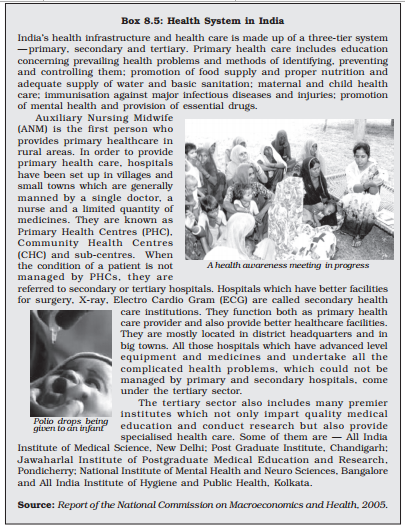
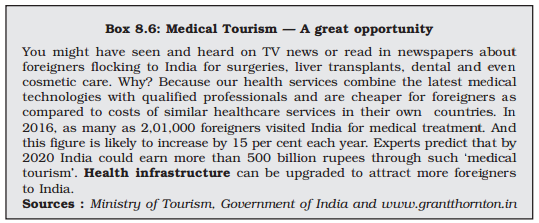

Since the 1990s, owing to liberalisation measures, many non-resident Indians and industrial and pharmaceutical companies have set up state-of-the-art super-specialty hospitals to attract India’s rich and medical tourists (see Box 8.6). Do you think most people in India can get access to such super-specialty hospitals? Why not? What could be done so that every person in India could access a decent quality healthcare?
Indian Systems of Medicine (ISM): It includes six systems—Ayurveda, Yoga, Unani, Siddha, Naturopathy and Homeopathy (AYUSH). At present, there are 3,943 AYUSH hospitals and 27,700 dispensaries and as many as 7.4 lakh registered practitioners in India. But little has been done to set up a framework to standardise education or to promote research.
ISMs have huge potential and can solve a large part of our healthcare problems because they are effective, safe and inexpensive.
Indicators of Health and Health Infrastructure—A Critical Appraisal: As pointed out earlier, the health status of a country can be assessed through indicators, such as infant mortality and maternal mortality rates, life expectancy and nutrition levels, along with the incidence of communicable and
non-communicable diseases. Some of the health indicators, and India’s position, are given in Table 8.4. Scholars argue that there is greater scope for the role of government in the health sector. For instance, the table shows expenditure on health sector as 4.7 per cent of the total GDP. This is abysmally low as compared to other countries, both developed and developing.
One study points out that India has about 17 per cent of the world’s population but it bears a frightening
20 per cent of the global burden of diseases (GBD). GBD is an indicator used by experts to gauge the number of people dying prematurely due to a particular disease, as well as, the number of years spent by them in a state of ‘disability’ owing to the disease.
In India, more than half of GBD is accounted for by communicable diseases such as diarrhoea, malaria and tuberculosis. Every year around five lakh children die of water-borne diseases. The danger of AIDS is also looming large. Malnutrition and inadequate supply of vaccines lead to the death of 2.2 million children every year.

At present, less than 20 per cent of the population utilises public health facilities. One study has pointed out that only 38 per cent of the PHCs have the required number of doctors and only 30 per cent of the PHCs have sufficient stock of medicines.
Urban-Rural and Poor-Rich Divide: Though 70 per cent of India’s population lives in rural areas, only one-fifth of its hospitals (including private hospitals) are located in rural areas. Rural India has only about half the number of dispensaries. Out of about 6.3 lakh beds in government hospitals, roughly 30 per cent are available in rural areas. Thus, people living in rural areas do not have sufficient medical infrastructure. This has led to differences in the health status of people. As far as hospitals are concerned, there are only 0.36 hospitals for every one lakh people in rural areas, while urban areas have 3.6 hospitals for the same number of people. The PHCs located in rural areas do not even offer X-ray or blood testing facilities, which for a city dweller, constitutes basic healthcare. States, like Bihar, Madhya Pradesh, Rajasthan and Uttar Pradesh, are relatively lagging behind in healthcare facilities. In rural areas, the percentage of people who have no access to proper healthcare facilities has increased over the last few years.
Villagers have no access to any specialised medical care, like paediatrics, gynaecology, anaesthesia and obstetrics. Even though 380 recognised medical colleges produce about 44,000 medical graduates every year, the shortage of doctors in rural areas persists. While one-fifth of these doctor graduates leave the country for better monetary prospects, many others opt for private hospitals, which are mostly located in urban areas.
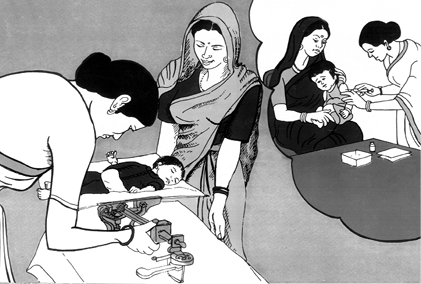
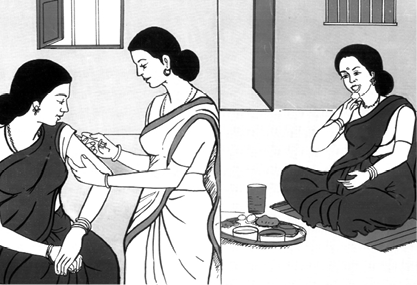
The poorest 20 per cent of Indians living in both urban and rural areas spend 12 per cent of their income on healthcare, while the rich spend only 2 per cent. What happens when the poor fall sick? Many have to sell their land or even pledge their children to afford treatment. Since government-run hospitals do not provide sufficient facilities, the poor are driven to private hospitals, which make them indebted forever, else they opt to die.
Women’s Health: Women constitute about half of the total population in India. They suffer many disadvantages as compared to men in the areas of education, participation in economic activities and healthcare. The deterioration in the child sex ratio in the country from 927 in 2001 to 914 in 2011 points to the growing incidence of female foeticide. Close to 3,00,000 girls aged below 15 years are not only married but have already borne children at least once. More than 50 per cent of married women in the age group of 15–49 years have anaemia and nutritional anaemia caused by iron deficiency, which has contributed to 19 per cent of maternal deaths. Abortions are also a major cause of maternal morbidity and mortality in India.
Health is a vital public good and a basic human right. All citizens can get better health facilities if public health services are decentralised. Success in the long-term battle against diseases depends on education and efficient health infrastructure. It is, therefore, critical to create awareness on health and hygiene and provide efficient systems. The role of telecom and IT sectors cannot be neglected in this process. The effectiveness of healthcare programmes also rests on primary healthcare. The ultimate goal should be to help people move towards a better quality of life. There is a sharp divide between urban and rural healthcare in India. If we continue to ignore this deepening divide, we run the risk of destabilising the socio- economic fabric of our country. In order to provide basic healthcare to all, accessibility and affordability need to be integrated in our basic health infrastructure.
8.7 Conclusion
Infrastructure, both economic and social, is essential for the development of a country. As a support system, it directly influences all economic activities by increasing the productivity of the factors of production and improving the quality of life. In the last seven decades of Independence, India has made considerable progress in building infrastructure, nevertheless, its distribution is uneven. Many parts of rural India are yet to get good roads, telecommunication facilities, electricity, schools and hospitals. As India moves towards modernisation, the increase in demand for quality infrastrucutre, keeping in view their environmental impact, will have to be addressed. The reform policies by providing various concessions and incentives, aim at attracting the private sector, in general, and foreign investors, in particular. While assessing the two infrastructure — energy and health, it is clear that there is scope for equal access to infrastructure for all.
Recap
Infrastructure is a network of physical facilities and public services and with this social infrastructure is equally important to support it. It is an important base for economic development of the country.
Infrastructure needs to be upgraded from time to time to maintain high economic growth rate. Better infrastructural facilities have attracted more foreign investments and tourists to India recently.
It is important to develop rural infrastructural facilities.
Public and private partnership is required to bring in huge funds for infrastructural development.
Energy is very vital for rapid economic growth. There is a big gap between consumer demand and supply of electricity in India.
Non-conventional sources of energy can be of great support to meet shortage of energy.
The power sector is facing a number of problems at generation, transmission and distribution levels.
Health is a yardstick of human well-being, physical as well as mental.
There has been significant expansion in physical provision of health services and improvements in health indicators since independence.
Public health system and facilities are not sufficient for the bulk of the population.
There is a wide gap between rural-urban areas and between poor and rich in utilising health care facilities.
Women’s health across the country has become a matter of great concern with reports of increasing cases of female foeticide and mortality.
Regulated private sector health services can improve the situation and, at the same time, NGOs and community participation are very important in providing health care facilities and spreading health awareness.
Natural systems of medicine have to be explored and used to support public health. There is a great scope of advancement of medical tourism in India.
EXERCISES
1. Explain the term ‘infrastructure’.
2. Explain the two categories into which infrastructure is divided. How are both interdependent?
3. How do infrastructure facilities boost production?
4. Infrastructure contributes to the economic development of a country. Do you agree? Explain.
5. What is the state of rural infrastructure in India?
6. What is the significance of ‘energy’? Differentiate between commercial and non-commercial sources of energy.
7. What are the three basic sources of generating power?
8. What do you mean by transmission and distribution losses? How can they be reduced?
9. What are the various non-commercial sources of energy?
10. Justify that energy crisis can be overcome with the use of renewable sources of energy.
11. How has the consumption pattern of energy changed over the years?
12. How are the rates of consumption of energy and economic growth connected?
13. What problems are being faced by the power sector in India?
14. Discuss the reforms which have been initiated recently to meet the energy crisis in India.
15. What are the main characteristics of health of the people of our country?
16. What is a ‘global burden of disease’?
17. Discuss the main drawbacks of our health care system.
18. How has women’s health become a matter of great concern?
19. Describe the meaning of public health. Discuss the major public health measures undertaken by the state in recent years to control diseases.
20. Differentiate the six systems of Indian medicine.
21. How can we increase the effectiveness of health care programmes?
SUGGESTED ADDITIONAL ACTIVITIES
1. Did you know that to bring a megawatt of electricity to your homes, 30-40 million rupees are spent? Building a new power plant would cost millions. Isn’t this reason enough for you to begin conserving energy in your house? Electricity saved is money saved; in fact, it is worth much more than electricity generated. Every time your electricity bill reaches home, you realise there is no need for so many lights and fans around you. All you have to do is be slightly more alert and careful. And the best thing is, you can start right away. Involve the rest of your family in this effort and see the difference. Note down the monthly consumption of electricity in your house. See the difference in the bill amount after you apply energy saving tactics.
(i) The budget allotted for the project.
(ii) The sources of its financing.
(iii) How much employment will it generate?
(iv) What will be the overall benefits after its completion?
(v) How long will it take to be completed?
(vi) Company/companies engaged in the project.
3. Visit any nearby thermal power station/hydro-power station/nuclear power plant. Observe how these plants work.
4. The class can be divided into groups to make a survey of energy use in their neighbourhood. The aim of the survey should be to find out which particular fuel is most used in the neighbourhood and the quantity in which it is used. Graphs can be made by the different groups and compared to find out possible reason for preference of one particular fuel.
5. Study the life and work of Dr Homi Bhaba, the architect of modern India’s energy establishments.
6. Hold a classroom discussion or debate on — ‘warring nations make for an unhealthy world, so do warped attitudes and closed minds make for mental ill-health’.
REFERENCES
Books
Jalan, Bimal (Ed.). The Indian Economy — Problems and Prospects. Penguin Books, Delhi, 1993.
Kalam, A.P.J. Abdul with Y.S. Rajan. 2002. India 2020: A Vision for the New Millennium. Penguin Books, Delhi.
Parikh, Kirit S. and Radhakrishna (Eds.). 2005. India Development Report
2004-05. Oxford University Press, Delhi.
Government Reports
Energy Statistics 2016, Ministry of Statistics and Programme Implementation, Government of India.
The World Health Report 2002. Reducing Risks, Promoting Healthy Life, World Health Organisation, Geneva.
Report of the National Commission on Macroeconomics and Health, Ministry of Health and Family Welfare, Government of India, New Delhi, 2005.
Tenth Five Year Plan, Vol.2, Planning Commission, Government of India, New Delhi.
The India Infrastructure Report: Policy Imperatives for Growth and Welfare 1996. Expert Group on the Commercialisaton of Infrastructure Projects. Vols.1, 2 and 3 Ministry of Finance. Government of India, New Delhi.
World Development Report 2004. The World Bank, Washington DC.
India Infrastructure Report 2004. Oxford University Press, New Delhi.
Economic Survey 2004-2005. Ministry of Finance, Government of India.
World Development Indicators, 2013, The World Bank, Washington.
World Health Statistics 2014, World Health Organisation, Geneva.
National Health Profile (NHP) of India for various years, Central Bureau of Health Intelligence, Goverment of India, New Delhi.
Websites
On energy related issues:
www.pcra.org
www.bee-india.com
www.edugreen.teri.res.in
http://powermin.nic.in
On health related issues:
http://www.aiims.edu
http://www.whoindia.org
http://mohfw.nic.in
www.apollohospitalsgroup.com
www.worldbank.org
www.cbhidghs.nic.in

